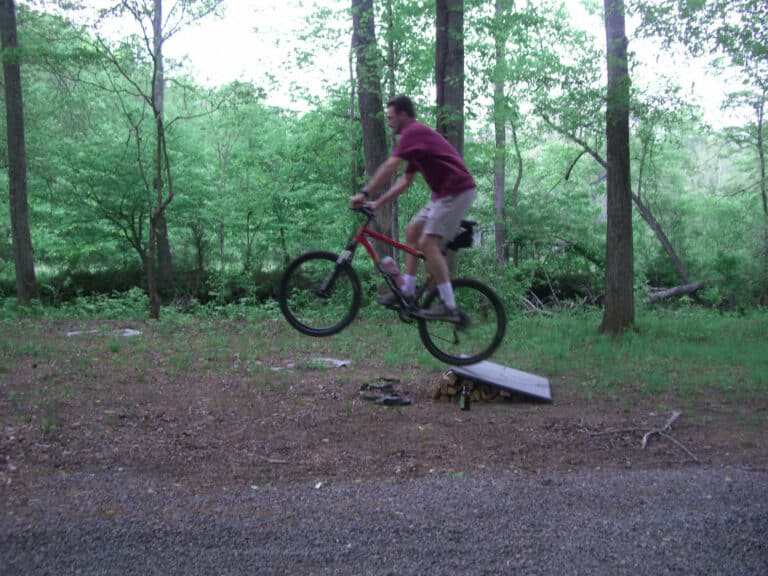ONLINE RESULTS: 68% NO
| 32% YES
The speed and weight of mountain bikes on the trail make them far more damaging than hikers’ bootsteps—especially on the Southeast’s wet, muddy trails.
<em>
—Gene Nicholson, Atlanta,Ga.</em>
———-
Mountain bikers do more damage to trails than other forms of trail users, primarily because of their sheer numbers and the ease with which the riders can lug their bikes to trailheads to reach sensitive foot trails. Yes, horses’ hooves can do a number on trails, and they do their share of damage. But a single mountain bike causes loads of damage with its knobby tires, skids, and chain rings over fallen logs.
<em>
—Karl Kunkel, High Point, N.C.</em>
———-
I’ve seen mountain bikers modify trails to make them easier by removing rocks, cutting roots, cutting fallen trees, building jumps, and braiding trails. I also have seen skid marks and riding in the mud that contributes to erosion. Besides the physical issues, you also have some irresponsible riders going too fast down busy trails. I’m not saying that every single mountain biker is damaging the trails, but there is a significant amount of damage done by the irresponsible ones.
<em>
—Jon Livengood, Knoxville, Tenn.</em>
———-
Bikes rut out the trails more than feet. However, I don’t mind because I like to use the trails for hiking, running, and biking. We have some trails here in town designated “no bikes” for folks who only want to use their feet, and as long as bikers respect them, it’s cool.
<em>
—Charlotte Matheny, Greensboro, N.C.</em>
———-
It’s fairly simple. On the average, mountain bikes have a greater frequency of moments when they are teetering on the edge of control than do people simply placing feet down on a path. So they cause a greater frequency of accidents and tires skidding out on the edge of a path, thus widening the dirt path and adding to erosion and sedimentation. But the good news is mountain bikers who actively volunteer to maintain trails are probably a net benefit.
<em>
—John Rudmin, Harrisonburg, Va.</em>
———-
Bikers damage the trail more other user groups, which is okay when the trail is made specifically for biking, but not fair when the trail is open to hikers and other user groups.
<em>
—Ed McKeown, Roanoke, Va.</em>
———-
I have been riding mountain bikes for several years now and have seen firsthand the more extreme damage that horses do to trails. You could easily do a test. Take 10 mountain bikers and ride a trail, then take 10 horses and ride the same trail. The results would be very clear. Plus, my bike has never taken a dump on the trail and left it for everyone else to ride and walk through.
<em>
—Rick Wilson, Brevard, N.C.</em>
———-
All user groups have an impact on trails. Whether one user group does more damage than the other depends on location, weather, terrain, and other environmental features. We all have an impact. More groups and indivudals need to get involved in trail care. Be part of the solution, not the problem.
<em>
—Woody Elliot, Richmond, Va.</em>
———-
The “footprint” from a bicycle is minimal at best—certainly not as bad as a motorcycle or ATV. Hikers try to use that argument to keep bikes off of the trails so that they can have them to themselves. There’s plenty of room for everyone: just be courteous to all and there should be no problems.
<em>
—Joe McAlister, Greer, S.C.</em>
———-
It’s not necessarily the bike or the equipment—it’s the rider who should be in control and respectful of the environment in every way.
<em>
—Tammy Orr, Roanoke, Va.</em>
———-
Poor trail design, construction, and maintenance damage the trails more than any single user group. It has been my experience that any trail can be damaged by any user group, and squabbling over who is to blame is counter-productive. Instead we should be looking at who is using a trail, in what manner, and how that trail can be made sustainable. Pointing fingers is a complete waste of time.
<em>
—Eddie O’Dea, Atlanta, Ga.</em>
———-
Water runoff does far more damage than either mountain bikers or hikers. Poor trail design is the main factor in determining how fast a trail erodes. On poorly designed trails, both user groups loosen soil, and this disturbed soil is available for the next rainstorm to take it away.
<em>
—Woody Keen, President, Professional Trailbuilders Association, Asheville, N.C.</em>
———-
If anyone has any doubts about what group of outdoor enthusiasts do the most damage to a trail, try and take a walk on the Virginia Horse Trail on Mount Rogers, especially the section that meanders to Elk Garden. Talk about an absolute disaster:You need waders to navigate it. It’s a mud pit on any given day, causing you to sink up to your knees in areas. I have never seen a mountain bike trail cause comparable damage.
<em>
—Jeff Buckley, Damascus, Va.</em>







